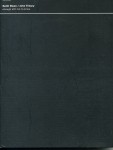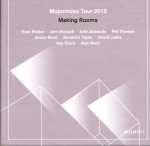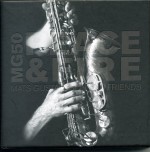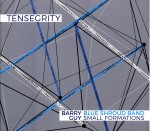 Multi-Disc Box Sets Offer Depth As Well As Quantity
Multi-Disc Box Sets Offer Depth As Well As Quantity
When a CD box of improvised music appears it customarily marks a critical occasion. So it is with these recent four-disc sets. One celebrates an anniversary tour by nine of London’s most accomplished improvisers. Another collects small group interactions in Krakow by musicians gathered to perform as an orchestra. A third is a souvenir of concerts celebrating Swedish saxophonist Mats Gustafsson’s 50th birthday. Finally enough still not to know captures extended improvisations by pianist John Tilbury and tabletop guitarist Keith Rowe, who have worked with one another on and off for 40 years.
Although the other sets can be likened to North American self-serve buffets that on the same sideboard offer an assortment of dishes, the Rowe-Tilbury box (SOFA 548 sofamusic.no) is like a superior fish-and-chips restaurant. The fare is phenomenal, but no substitutions are entertained. At points each musician appears to be following an intense chess game from another room – you know concentrated cerebral strategy is taking place, but you’re unable to observe the participants. A good portion of the four, hour-long Tilbury-Rowe faceoffs also involve protracted silences. Perhaps the liveliest disc is Second Part where interactions are more audible. Like the tantalizing hints of understated perfume before a person enters a room, Tilbury’s single note chiming unfolds into serialism-like suggestions and more surprising near-impressionist echoes. Perhaps fancifully reflecting his radical-left politics, Rowe sets himself up as the disrupter, twisting dials and shuffling objects with percussive gestures. The upshot is desiccated textures that still reflect back on the pianist’s paced narrative. If anything the music is Feldmanesque – like Morton Feldman. The performances take a great amount of time to not advance that much. Still the final section of Second Part spawns a sequence where what sounds like heavy-object moving transforms into conga-like slaps and cymbal-resembling pings on the guitarist’s part met by piano bottom board rapping from the keyboardist. Tilbury’s noodling that dwindles to a single key stroke at the end relates back to the piece’s low-pitched introduction. A similar bagpipe-like tremolo shuddering on Rowe’s part is matched by mallet-on-strings pop from the piano innards during the ending of Third Part. Those cognizant with the ingredients of improvised music will revel in the set. But most should approach it one disc at a time.
 A British pianist whose style is Tilbury’s antithesis is Pat Thomas, whose solo CD, Nasqsh, is one of the highpoints of Making Rooms (Weekertoft 1-4 weekertoft.com). With Mopomoso Tour 2013 celebrating the 21st year of this initiative in free-form music, the others discs in the set are vocalist Kay Grant and clarinetist Alex Ward’s Seven Cities; violinist Allison Blunt, violist Benedict Taylor and bassist David Leahy’s Knottings; and Chasing the Peripanjarda with saxophonist Evan Parker, bassist John Edwards plus Mopomoso founder, guitarist John Russell. Playing nine selections Thomas ranges chameleon-like over and inside the piano producing textures ranging from buzzing string swirls to aggressive, staccato lines that involve the piano’s wooden components as much as its strings and keys. On for Martin Lings Thomas’ theme balances echoing glissandi, key clicks and a faux waltz; whereas for al Battani is a near-boogie-woogie with flashing chords reflecting back unto one another. The letter is as romantic in execution as ibn Arabi could be musique concrète, with Thomas cascading harp-like arpeggios from the strings. Named for the seven cities in which it was recorded, the Grant-Ward recital finds the vocalist and reedist operating like conjoined twins, with fascination lying in how many timbres each replicates from the other. With Ward’s tone frequently altissimo and atomized, and Grant eschewing lyricism for quickened yelps and screeches, the effect is like peering at two near-identical drawings from which you have to intuit the subtle differences. Like a distorted funhouse mirror, Blunt/Taylor/Leahy create loosened-up chamber music. They use so-called classical tunings to rub and wiggle unexpected, contradictions from their instruments. Thickened pizzicato with mandolin-like plucks keeps a track like Sheet Bend exciting. A sense of hairline-triggered dynamics allows Noose to loosen from nearly inaudible to detonate into an exercise in col legno and sul ponticello trills. Slip Knot is like an upstairs-downstairs soundtrack as Edwardian drawing room formality is swept aside by shrill runs which jump and split like a jitterbug dancer. The trio’s skill is confirmed in how it manages to impart a romantic patina while distorting themes. The latter skill is habitual for Parker/Edwards/Russell. Like a reversible garment that’s both familiar and flashy, each of their tracks defines in-the-moment improv. Gunpowder, for example, never detonates into smithereens but stretches elastically without breaking. Parker’s focused snarls and tongue extensions transmit the theme decorated with no-nonsense strums and smacks from Russell, as Edwards holds the road like a racing car driver. The triple connection is such that partway through you notice that the tempo has sped up immeasurably from a canter to a Olympic-level race yet neither the tune’s seemingly limitless motion nor the trio’s interaction has perceptibly altered. The Auction of Pictures is even more animated as the saxophone unleashes just the proper amount of circular breathing.
A British pianist whose style is Tilbury’s antithesis is Pat Thomas, whose solo CD, Nasqsh, is one of the highpoints of Making Rooms (Weekertoft 1-4 weekertoft.com). With Mopomoso Tour 2013 celebrating the 21st year of this initiative in free-form music, the others discs in the set are vocalist Kay Grant and clarinetist Alex Ward’s Seven Cities; violinist Allison Blunt, violist Benedict Taylor and bassist David Leahy’s Knottings; and Chasing the Peripanjarda with saxophonist Evan Parker, bassist John Edwards plus Mopomoso founder, guitarist John Russell. Playing nine selections Thomas ranges chameleon-like over and inside the piano producing textures ranging from buzzing string swirls to aggressive, staccato lines that involve the piano’s wooden components as much as its strings and keys. On for Martin Lings Thomas’ theme balances echoing glissandi, key clicks and a faux waltz; whereas for al Battani is a near-boogie-woogie with flashing chords reflecting back unto one another. The letter is as romantic in execution as ibn Arabi could be musique concrète, with Thomas cascading harp-like arpeggios from the strings. Named for the seven cities in which it was recorded, the Grant-Ward recital finds the vocalist and reedist operating like conjoined twins, with fascination lying in how many timbres each replicates from the other. With Ward’s tone frequently altissimo and atomized, and Grant eschewing lyricism for quickened yelps and screeches, the effect is like peering at two near-identical drawings from which you have to intuit the subtle differences. Like a distorted funhouse mirror, Blunt/Taylor/Leahy create loosened-up chamber music. They use so-called classical tunings to rub and wiggle unexpected, contradictions from their instruments. Thickened pizzicato with mandolin-like plucks keeps a track like Sheet Bend exciting. A sense of hairline-triggered dynamics allows Noose to loosen from nearly inaudible to detonate into an exercise in col legno and sul ponticello trills. Slip Knot is like an upstairs-downstairs soundtrack as Edwardian drawing room formality is swept aside by shrill runs which jump and split like a jitterbug dancer. The trio’s skill is confirmed in how it manages to impart a romantic patina while distorting themes. The latter skill is habitual for Parker/Edwards/Russell. Like a reversible garment that’s both familiar and flashy, each of their tracks defines in-the-moment improv. Gunpowder, for example, never detonates into smithereens but stretches elastically without breaking. Parker’s focused snarls and tongue extensions transmit the theme decorated with no-nonsense strums and smacks from Russell, as Edwards holds the road like a racing car driver. The triple connection is such that partway through you notice that the tempo has sped up immeasurably from a canter to a Olympic-level race yet neither the tune’s seemingly limitless motion nor the trio’s interaction has perceptibly altered. The Auction of Pictures is even more animated as the saxophone unleashes just the proper amount of circular breathing.
 Circular breathing is just one of techniques exhibited by birthday boy Mats Gustafsson, on MG50 Peace & Fire at Porgy & Bess (Trost Records TR 140 trost.at). In honour of his 50th the Swedish saxophonist mixed and matched 30 associates in various ensembles. Although the effect is somewhat like moving through a raucous, outdoor carnival into a near-soundproof laboratory and back out onto a noisy speedway, the tracks confirm the reedist’s breadth. Gustafsson sounds exactly like himself whether he plays alto, tenor, baritone, bass saxophones or self-invented flutophone and whether he’s lobbing power shards against the industrial-style drumming of Didi Kern on Peace or advancing hard pitches that are descriptive without being disruptive while embedded among the reeds, brass and strings of Klangforum Wien on Konstellation. A track such as Molting Slowly (without noticing), where his Fire trio of electric bassist Johan Berthling and drummer Andreas Werliin is augmented with two vocalists, electric organ and bagpipes [!], sashays from bedlam-styled vocalizing and reed shrieks to Death Metal-like melodrama without letting the menacing theme overcome the supple voice and instrumental interaction. Similarly a meeting of his The Thing trio – bassist Ingebrigt Håker Flaten and drummer Paal Nilssen-Love – with saxophonist Ken Vandermark on tracks like Unheard. I Yield may feature a saxophone faceoff with tones winding around one another like snakes in a mating ritual, but a final bass-led descent to an R&B-like pulse adds swing to the tough reed mass. Suspended within an electrified concerto with synthesizer player Thomas Lehn, drummer Paul Lovens and trombonist/cellist Günter Christmann, Gustafsson meshes thick reed tones with hissing synth vibrations as carefully as he uses singular puffs to connect with isolated drum strokes and string plinks. Plus, when his Swedish Azz quintet which include Dieb13’s turntables plus tuba, saxophone, vibe and drums gets going on a piece like Quincy processed samples and unexpected reed tongue flutters confirm the band’s contemporary bona fides even as the theme salutes Sweden’s mid-century modern jazz roots.
Circular breathing is just one of techniques exhibited by birthday boy Mats Gustafsson, on MG50 Peace & Fire at Porgy & Bess (Trost Records TR 140 trost.at). In honour of his 50th the Swedish saxophonist mixed and matched 30 associates in various ensembles. Although the effect is somewhat like moving through a raucous, outdoor carnival into a near-soundproof laboratory and back out onto a noisy speedway, the tracks confirm the reedist’s breadth. Gustafsson sounds exactly like himself whether he plays alto, tenor, baritone, bass saxophones or self-invented flutophone and whether he’s lobbing power shards against the industrial-style drumming of Didi Kern on Peace or advancing hard pitches that are descriptive without being disruptive while embedded among the reeds, brass and strings of Klangforum Wien on Konstellation. A track such as Molting Slowly (without noticing), where his Fire trio of electric bassist Johan Berthling and drummer Andreas Werliin is augmented with two vocalists, electric organ and bagpipes [!], sashays from bedlam-styled vocalizing and reed shrieks to Death Metal-like melodrama without letting the menacing theme overcome the supple voice and instrumental interaction. Similarly a meeting of his The Thing trio – bassist Ingebrigt Håker Flaten and drummer Paal Nilssen-Love – with saxophonist Ken Vandermark on tracks like Unheard. I Yield may feature a saxophone faceoff with tones winding around one another like snakes in a mating ritual, but a final bass-led descent to an R&B-like pulse adds swing to the tough reed mass. Suspended within an electrified concerto with synthesizer player Thomas Lehn, drummer Paul Lovens and trombonist/cellist Günter Christmann, Gustafsson meshes thick reed tones with hissing synth vibrations as carefully as he uses singular puffs to connect with isolated drum strokes and string plinks. Plus, when his Swedish Azz quintet which include Dieb13’s turntables plus tuba, saxophone, vibe and drums gets going on a piece like Quincy processed samples and unexpected reed tongue flutters confirm the band’s contemporary bona fides even as the theme salutes Sweden’s mid-century modern jazz roots.
 Another variation on a similar theme is Tensegrity (NotTwo MW938-2 nottwo.com). Here the 14 members of British bassist Barry Guy’s Blue Shroud Band, gathered in Krakow to perform the bassist’s orchestral Blue Shroud, were recorded in Small Formations. The set features 26 tracks where band members from 10 countries demonstrate their skills. Some improvisations are unexpected, as when four reed players stack up so many timbres that are alternately shrill, subterranean, harsh and gentle, that it appears critical mass is reached. Then they’re joined by serpent-player Michael Godard, whose hunting-horn-like subtly adds a further subterrestrial dimension. On one track, Bach specialist Maya Homburger reads her violin part, but backed by Guy’s four-square bass and the creative accents of percussionist Lucas Niggli the result is easy swing. Other assemblages are more customary. Guy’s mufti-directional arpeggios and percussionist Ramón López’s pacing draw out the best from saxophonist Julius Gabriel so that his flutters, reed kisses and slurps culminate in a set that salutes both the hushed improv of Mopomoso and Gustafsson-style Energy Music. Vocalist Savina Yannatou showcases her tonal sensitivity or creates a hubbub of sounds scatted and otherwise equal to the instrumentalists’ free playing. Overall the MVP is Catalan pianist Agustí Fernández. On his own he mixes highly technical carefully prepared string additions to create a kaleidoscopic solo that’s as percussively syncopated as it is breezy. On the set’s final track he joins Guy, López, trumpeter Peter Evans and Yannatou for a matchless half-hour improvisation. Sequences successively resemble a classic piano trio; a rhythmic safety net for Evans’ tongue gymnastics; and focused backing for the vocalist’s mumbles and speaking in tongues. Throughout, the pianist draws unexpected glissandi and inner-piano resonations like gold nuggets from a stream to both match and accompany the other soloists.
Another variation on a similar theme is Tensegrity (NotTwo MW938-2 nottwo.com). Here the 14 members of British bassist Barry Guy’s Blue Shroud Band, gathered in Krakow to perform the bassist’s orchestral Blue Shroud, were recorded in Small Formations. The set features 26 tracks where band members from 10 countries demonstrate their skills. Some improvisations are unexpected, as when four reed players stack up so many timbres that are alternately shrill, subterranean, harsh and gentle, that it appears critical mass is reached. Then they’re joined by serpent-player Michael Godard, whose hunting-horn-like subtly adds a further subterrestrial dimension. On one track, Bach specialist Maya Homburger reads her violin part, but backed by Guy’s four-square bass and the creative accents of percussionist Lucas Niggli the result is easy swing. Other assemblages are more customary. Guy’s mufti-directional arpeggios and percussionist Ramón López’s pacing draw out the best from saxophonist Julius Gabriel so that his flutters, reed kisses and slurps culminate in a set that salutes both the hushed improv of Mopomoso and Gustafsson-style Energy Music. Vocalist Savina Yannatou showcases her tonal sensitivity or creates a hubbub of sounds scatted and otherwise equal to the instrumentalists’ free playing. Overall the MVP is Catalan pianist Agustí Fernández. On his own he mixes highly technical carefully prepared string additions to create a kaleidoscopic solo that’s as percussively syncopated as it is breezy. On the set’s final track he joins Guy, López, trumpeter Peter Evans and Yannatou for a matchless half-hour improvisation. Sequences successively resemble a classic piano trio; a rhythmic safety net for Evans’ tongue gymnastics; and focused backing for the vocalist’s mumbles and speaking in tongues. Throughout, the pianist draws unexpected glissandi and inner-piano resonations like gold nuggets from a stream to both match and accompany the other soloists.
Each box here has something to offer the adventurous. Together they add up to a faultless picture of contemporary improvised music.



